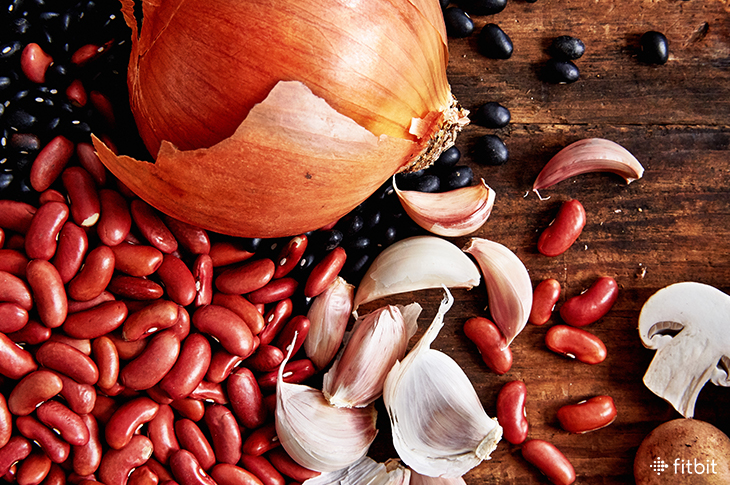
Sure, a greasy burger can give you a stomachache. But if you suffer from frequent tummy troubles, some unsuspecting foods may be to blame. No, it’s not just gluten or dairy—think onions and apples. Many common—and often healthy—foods contain something called FODMAPs. Research shows that only 8 percent of people who believe they’re gluten sensitive actually are, and the rest are likely reacting to FODMAPs. So if you’re desperate for relief and already dabbling in elimination diets, science says, this is the one to try.
What Are FODMAPs?
What exactly are FODMAPs? That stands for fermentable ogliosaccharides, disaccharides, monosaccharides, and polyols. Translation: They’re types of sugar that are found naturally in many foods. “These sugars aren’t digested or absorbed well,” explains Peter Gibson, MD, a professor of gastroenterology at Monash University in Australia. FODMAPs draw water into the small intestine, which can cause bloating and diarrhea. They’re also fermented by the natural bacteria in your colon, which may lead to gassiness, pain, and other digestive issues.
Most of us are able to digest FODMAPs without any issue—they’re even good for you. But Gibson estimates that for 10 percent of people, even a small amount of these sugars can set off symptoms. How can you tell if you’re one of them? “There’s no simple test,” says Robin Foroutan, RDN, an integrative dietitian nutritionist in New York City and spokesperson for the Academy of Nutrition and Dietetics. “The only way to tell is by temporarily avoiding certain foods to see if you feel better.”
Which Foods Are High in FODMAPs?
FODMAPs are found naturally in a wide range of foods, so for more information, check out these resources from Monash University. But some examples include:
- Certain vegetables, such as onions, asparagus, garlic, and celery.
- Some fruits, such as apples, pears, watermelon, peaches, and plums.
- Dairy products, including milk and yogurt.
- Wheat products, including pasta and bread.
- Certain processed ingredients, such as high fructose corn syrup and the sugar substitutes xylitol and sorbitol.
Note: Gluten and FODMAPs are often in the same foods, so going gluten-free may make you feel somewhat better. But the true culprit could actually be FODMAPs.
How to Try a Low-FODMAP Diet
Unfortunately, you can’t just skip a few foods for a few days and expect a miracle cure. To really know if you have an issue with FODMAPs, you have to cut all high-FODMAP foods completely out of your diet for 2 to 6 weeks. No relief from your tummy troubles? Then you’re not sensitive, and there’s no reason to continue the diet. But if you do feel better, you move onto the second stage. That’s when you reintroduce those FODMAP foods, one by one. This lets you figure out which foods—and how much of them—set off your symptoms. “Once you identify triggers, you can go back to eating your regular diet,” says Foroutan. “Except you know to steer clear of or only eat a small amount of those specific foods.”
But Do You Really Need an Elimination Diet?
For gastrointestinal issues, such as irritable bowel syndrome (IBS), this eating plan has been shown to provide relief in 75 percent of people—a huge difference for their quality of life (they even reported sleeping more soundly). But you should never go on an elimination diet unless it’s absolutely necessary. If you’re healthy, this approach won’t give you a flatter, bloat-free belly or serve up any other benefits, says Foroutan. “Plus, many of the foods that you’re eliminating, such as avocados and beans, are good for you.”
Not to mention, elimination diets require a lot of discipline. If you have a real issue, talk to your doctor and get a dietitian’s guidance. There are so many high-FODMAP foods out there that doing it on your own is tough. “If you don’t follow the diet properly, you may have few or no benefits,” warns Gibson. “Don’t waste the effort for unclear results.” Your dietitian will probably recommend keeping a food diary, and you may need to eat in for a few weeks, since restaurants won’t recognize many of these foods as allergens. But your dietitian can offer meal ideas and make sure you don’t fall short on important nutrients by suggesting healthy swaps, such as green beans instead of asparagus and almonds in place of cashews.
“Cutting out FODMAPs can be really tough, because it’s so restrictive,” says Foroutan. “But it’s only temporary, and it can make a world of difference.”
The post WTF Are FODMAPs? The Ultimate Elimination Diet appeared first on Fitbit Blog.
Source: Fitbit Blog
—